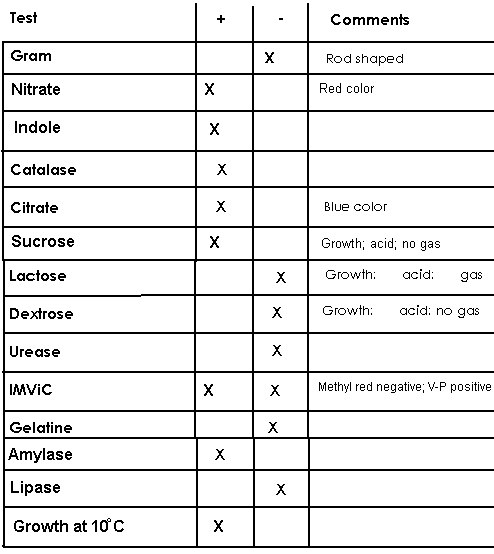

Brian Wiedemer - Klebsiella Oxytoca
This isolate was extracted from the non-lit column on a slide placed directly on top of the mud. As with all of our isolates, this was plated and later repeatedly streaked in order to isolate a lone colony. After my previous isolates had died over spring break, my new isolate was obtained in early April, following our return to campus, from the same area of the non-lit column. My new isolate was first plated for growth and then streaked onto two plates; one placed into the incubation closet at 37 degrees Celsius, the other into my laboratory drawer at 25 degrees Celsius. It was observed that the organisms fastest growth rate occurred at 37 degrees Celsius. I also observed this unknown bacteria form dull-yellow pigmented colonies during it’s optimal growth.
To begin the identification process, I performed a Gram stain. My results were confirmed as Gram (-) with a rod cell type arranged singly. My next step in the identification process involved consulting the Bergey’s Manual Separation Outline for gram-negative rods on page 121-122 of our Customized Microbiology Laboratory Manual. I followed this outline performing a stab culture into a TSA slant to determine my isolate’s oxygen requirements. My unknown organism was found to be facultatively anaerobic. In continuation of following the identification flow chart, I then tested for my organisms capabilities of motility. Using high density agar, my organism was found to be completely non-motile. I followed this by performing a Citrate Test. My organism showed results of a Citrate (+) bacteria. According to the flow chart, my isolate was from the genus Klebsiella.
Not completely convinced that I had positively identified my organism to the genus level, I consulted Bergey’s Manual to find testable characteristics of this bacteria. I found information on expected results for all species of Klebsiella. These tests included positive results for the Catalase Test, Nitrate Reduction Test, and the fermentation of Common Carbohydrates. In the following days, I preformed these experiments only to further confirm that my unknown species was of the genus Klebsiella.
I then decided to run a series of tests to determine my Klebsiella isolate to the species level. Of the many tests I ran the Indole Test and test for growth at 10 degrees Celsius proved crucial to my species identification. A positive result on the Indole test narrowed my Klebsiella variety down to three possible species. Of these three, my Klebsiella isolate was the only species to grow at 10 degrees Celsius. This confirmed a positive identification of my isolate to the species level. My isolate was Klebsiella Oxytoca.
From the tests that I already performed, I knew that I was dealing with an organism that was a gram negative, non-motile, facultative anaerobe with singly arranged rods that could bare extreme temperatures down to at least 10 degrees Celsius. It could also transport Citrate into the cell and use ammonium ions. In addition, Klebsiella can reduce nitrates, hydrolyze the amino acid tryptophan into indole, and can metabolize Sucrose and Dextrose producing an acid by-product. Lastly, it can metabolize Lactose producing both an acid and gas.
Following this identification, I decided to perform a series of tests to find out additional information about my organisms capabilities in terms of it’s environment and metabolism. I then produced results for Lipase, Amylase, Gelatin, Urease, Catalase, Methyl Red, and Voges-Proskauer Tests. While it can’t hydrolyze Gelatin or Lipids for digestion, it was found able to hydrolyze starch for digestion and detoxify urea and hydrogen peroxide. It was not found to produce large amounts of acid from a negative Methyl Red result, but a positive result in the Voges-Proskauer test showed it capable of butanediol fermentation.
According to Bergey’s Manual, and important to our Winogradsky column, Klebsiella occurs in human feces, clinical specimens, soil, and water. This information is consistent with the fact that our samples were acquired from Big Walnut Creek, just behind the waste-water treatment plant. Lastly, Klebsiella Oxytoca has been found to be an opportunistic pathogen that can cause pneumonia, bacteremia, and urinary tract infections.

